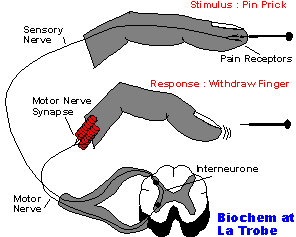Table of Endocrine glands, their hormones and the hormone action.
| ENDOCRINE GLAND |
HORMONE |
ACTION |
| THYROID |
Throxine, other thyroxine-like hormones |
Stimulation and regulation of rate of cellular metabolism |
| THYROID |
Calcitonin |
Inhibits release of calcium from bone. |
| PARATHYROID |
Parathyroid hormone (PTH) |
Stimuates release of calcium from bone. |
| ADRENAL CORTEX |
Aldosterone |
Affects water and salt balance by reabsorption of sodium and excretion of potassium. |
| ADRENAL CORTEX |
Cortisol, other corticosteriods |
Affect carbohydrate, fat and protein metabolism. |
| ADRENAL MEDULLA |
Adrenaline and noradrenaline |
Increase blood [glucose], alter diameter of blood vessels (some constrict, others dilate), increase rate and strength of heart beat. (The 'fight or flight' response to stress.) |
| OVARY |
Oestrogens |
Develop and maintain female sex characteristics. Initiate accumulation of blood on uterine wall during menstrual cycle. |
| OVARY |
Progesterone |
Promotes continuation of growth of uterine lining during menstrual cycle. |
| TESTIS |
Androgens |
Promote sperm production. Develop and maintain male sex characteristics. |
| PANCREAS |
Insulin |
Stimulates uptake of gluocse into tissues in response to high blood [glucose]. |
| PANCREAS |
Glucagon |
Stimulates release of glucose from tissue glycogen stores in response to low blood [glucose]. |
| POSTERIOR PITUITARY |
Anti diuretic hormone (ADH) |
Controls water excretion by kidneys. |
| POSTERIOR PITUITARY |
Oxytocin |
Stimulates uterine contraction during childbirth. Stimulates milk secretion. |
| ANTERIOR PITUITARY |
Follicle-stimulating hormone (FSH) |
Stimulates follicle formation in female and sperm formation in male. |
| ANTERIOR PITUITARY |
Lutenising hormone (LH) |
Stimulates ovulation in females and androgen secretion in males. |
| ANTERIOR PITUITARY |
Thyroid stimulating hormone (TSH) |
Stimulates and maintains metabolism by regulating the thyroid gland. |
| ANTERIOR PITUITARY |
Adrenocorticotropic hormone (ACTH) |
Stimulates and regulates the adrenal cortex. |
| ANTERIOR PITUITARY |
Growth hormone (GH) or somatotropin |
Stimulates bone growth, inhibits glucose breakdown, stimulates fat breakdown. |
| ANTERIOR PITUITARY |
Prolactin |
Stimulates milk production |
| ANTERIOR PITUITARY |
Melanocyte stimulating hormone (MSH) |
Increases synthesis of melanin (skin pigment). |
| HYPOTHALAMUS |
Releasing hormones (many) (RH) |
These hormones travel from hypothalamus to the ant. pituitary, triggering the release of the appropriate ant. pituitary hormone. |
Some other secretions and their actions.
| Secretion or secretory tissue |
Comment on action |
| Exocrine glands |
These glands do not produce hormones, their secretions are enzymes or other molecules which leave the gland via ducts which empty them into the location where they are used. Examples, digestive enzymes from pancreas, tears. |
| Paracrine cells |
Cells which release hormones not into the circulatory system, but directly into adjacent cells or the surrounding extracellular fluid, where they have a very localised effect. These hormones are fatty acids, and include the prostaglandins which have a role in the sensation of pain. (Interestingly, asprin's action has been shown to inhibit the synthesis of prostaglandin - and so stop the sensation of pain.) |
| Neurocrine cells |
Hormone secreting cells whose secretory activity is stimulated directly by nerve endings. Example: Nerves in the hypothalamus stimulate certain regions of the posterior pituitary gland which, in turn, release hormones. |
| Neurotransmittors |
These chemicals qualify as hormones according to the definition of a hormone, but their special action in the nervous system sets them apart. |






